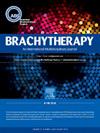MSOR8 Presentation Time: 5:35 PM
IF 1.7
4区 医学
Q4 ONCOLOGY
引用次数: 0
Abstract
Purpose
To elucidate systematic approach towards commissioning, implementing and establishing a high dose rate (HDR) interstitial brachytherapy (ISBT) program for head and neck cancers in a new tertiary cancer centre in India.
Materials and Methods
We present the systematic approach and challenges encountered during the implementation of ISBT for head and neck cancers and early outcome of patients treated between September 2020 and September 2022 at our Institution.
Results
In an established infrastructure for high Dose rate Brachytherapy, we explored implementing H & N BT. Joint tumor board discussions, reviewing of existing treatment guidelines and shared decision making with patients helped to start the program. A comprehensive disease mapping was done using clinical drawings (figure 1) & clinical pictures taken before EBRT and BT. Appropriate check list for performing BT procedure, discussions for anaesthesia requirements, dedicated team of Nurse, RTT & Medical physicist, BT planning and dose parameters were reviewed. A successful collaboration with dental surgeon to work on prosthesis especially to spare mandible for high dose regions was established which evolved from using simple rubber catheters, wax to customized acrylic spacers. All suitable patients were either offered radical BT or BT boost after completion of EBRT.A total of 18 patients diagnosed with early-stage oral cancer underwent treatment with ISBT, either as a boost following VMAT (n=13) or 3DCRT (n=2), or as BT Alone (n=3). The primary tumour sites were lateral border of the tongue (n=13), lip (n=3), and buccal mucosa (n=2). The median tumour size was 2 cm, with 13 cases classified as T1 and 5 as T2 with infiltrative lesion in 13 pts and proliferative lesion in remaining 5 pts.Three patients received ISBT alone (1 with buccal mucosa cancer, 2 with lip cancer), while 15 underwent concurrent neck irradiation alongside primary tumour treatment, with a median dose of 50 Gy in 25 fractions over 5 weeks, followed by HDR ISBT after a median gap of 31 days (IQR, 18-34 days). Most patients (n=9,50%) required implantation in two planes, with a median of 11 catheters (range 9-15). The median dose for ISBT boost cases was 22.5Gy in 5 fractions @ 4.5Gy/fraction, while for radical ISBT, it ranged from 40 Gy in 10 fr to 49.5 Gy in 11 fr. The EQD2 was 74 Gy (range: 69-77.5 Gy EQD2), and the median overall treatment time for combined EBRT and ISBT boost was 67 days (range: 47 - 88 days). Mandibular ISBT doses were limited to a median of 4.3 Gy (D 0.1 cc) and 3.15 Gy (D 1cc) per fraction with cumulative dose(Dmax) in EQD2 of 53Gy. The prescribed dose for radical ISBT ranged from 40 to 48 Gy in 10-15 fr.At the last follow-up, grade 1 xerostomia was reported in 38.9% of patients, with none experiencing grade 2 or higher xerostomia. One patient developed osteoradionecrosis of the mandible with minimal exposure of the alveolar bone(Mandibular dose of 81.1 Gy EQD2) . None of the patients experienced > grade 2 speech or swallowing dysfunction, although 5 (27.7%) reported sensitivity to spicy foods. At a median follow-up of 27 months (range, 29 to 35 months), the overall 2-year loco-regional control rate was 78%. Isolated local failure occurred in 5 patients (29.4%), while one patient experienced loco-regional failure and another had combined local and distant (lung metastases) failure. Salvage surgery was performed in four cases, resulting in disease control for 3 patients. One patient declined surgery, and another with distant metastasis received palliative care. The 2-year overall survival rate was 85.2%, with three patients deceased, two due to progressive disease.
Conclusions
A comprehensive multidisciplinary, multimodality team approach resulted in a successful implementation of HDR-ISBT for head & Neck Cancers with initial outcome demonstrating promising clinical outcomes.
MSOR8 演讲时间:下午 5:35
目的阐明在印度一家新的三级癌症中心委托、实施和建立头颈部癌症高剂量率(HDR)间质近距离放射治疗(ISBT)计划的系统方法。肿瘤委员会的联合讨论、对现有治疗指南的审查以及与患者共同决策,帮助我们启动了这项计划。我们使用临床图纸(图 1)和 EBRT 和 BT 前的临床照片绘制了全面的疾病图谱。对进行 BT 手术的适当检查清单、麻醉要求讨论、由护士、RTT 和医学物理学家组成的专门团队、BT 计划和剂量参数进行了审查。与牙科医生建立了成功的合作关系,共同设计假体,特别是为高剂量区域提供备用下颌骨,从使用简单的橡胶导管、蜡到定制的丙烯酸垫片。共有18名确诊为早期口腔癌的患者接受了ISBT治疗,包括VMAT(13人)或3DCRT(2人)后的增强治疗,或单独BT(3人)。原发肿瘤部位为舌外侧缘(13 例)、唇(3 例)和口腔粘膜(2 例)。3名患者仅接受了ISBT治疗(1名患有口腔粘膜癌,2名患有唇癌),15名患者在接受原发肿瘤治疗的同时接受了颈部照射,中位剂量为50 Gy,分25次,疗程5周,然后在中位间隔31天(IQR,18-34天)后接受HDR ISBT治疗。大多数患者(n=9,50%)需要在两个平面上植入导管,中位数为 11 根导管(9-15 根不等)。ISBT提升病例的中位剂量为22.5Gy,分5次进行,每次4.5Gy,而根治性ISBT的中位剂量范围为40Gy,分10次进行,每次49.5Gy,分11次进行。EQD2为74 Gy(范围:69-77.5 Gy EQD2),EBRT和ISBT联合增强治疗的总治疗时间中位数为67天(范围:47-88天)。下颌骨 ISBT 的剂量限制为每分中位数 4.3 Gy(D 0.1 cc)和 3.15 Gy(D 1cc),EQD2 的累积剂量(Dmax)为 53Gy。在最后一次随访中,38.9%的患者出现了1级口腔异味,没有人出现2级或以上的口腔异味。一名患者出现下颌骨骨坏死,牙槽骨暴露极少(下颌骨剂量为 81.1 Gy EQD2)。没有一名患者出现 2 级语言或吞咽功能障碍,但有 5 名患者(27.7%)表示对辛辣食物敏感。中位随访时间为 27 个月(29 至 35 个月),2 年的局部区域控制率为 78%。5例患者(29.4%)出现局部治疗失败,1例患者出现局部区域治疗失败,另1例患者出现局部和远处(肺转移)治疗失败。4例患者接受了挽救手术,其中3例患者的病情得到控制。一名患者拒绝手术,另一名有远处转移的患者接受了姑息治疗。2年总生存率为85.2%,3名患者死亡,其中2人死于疾病进展。
本文章由计算机程序翻译,如有差异,请以英文原文为准。
求助全文
约1分钟内获得全文
求助全文
来源期刊

Brachytherapy
医学-核医学
CiteScore
3.40
自引率
21.10%
发文量
119
审稿时长
9.1 weeks
期刊介绍:
Brachytherapy is an international and multidisciplinary journal that publishes original peer-reviewed articles and selected reviews on the techniques and clinical applications of interstitial and intracavitary radiation in the management of cancers. Laboratory and experimental research relevant to clinical practice is also included. Related disciplines include medical physics, medical oncology, and radiation oncology and radiology. Brachytherapy publishes technical advances, original articles, reviews, and point/counterpoint on controversial issues. Original articles that address any aspect of brachytherapy are invited. Letters to the Editor-in-Chief are encouraged.
 求助内容:
求助内容: 应助结果提醒方式:
应助结果提醒方式:


